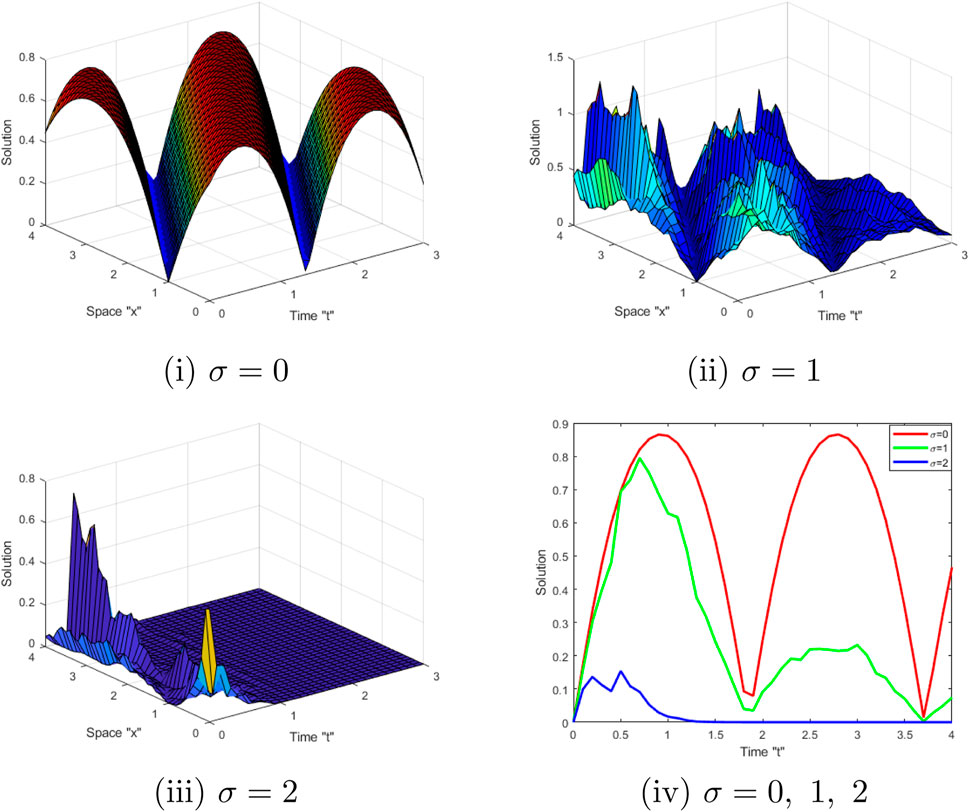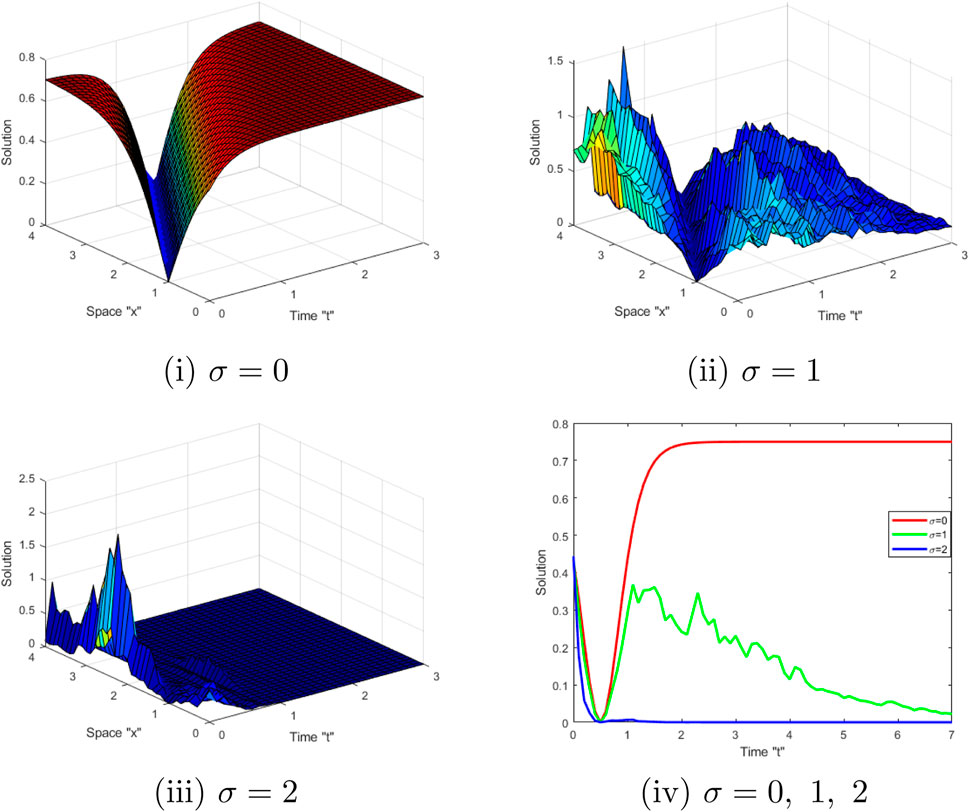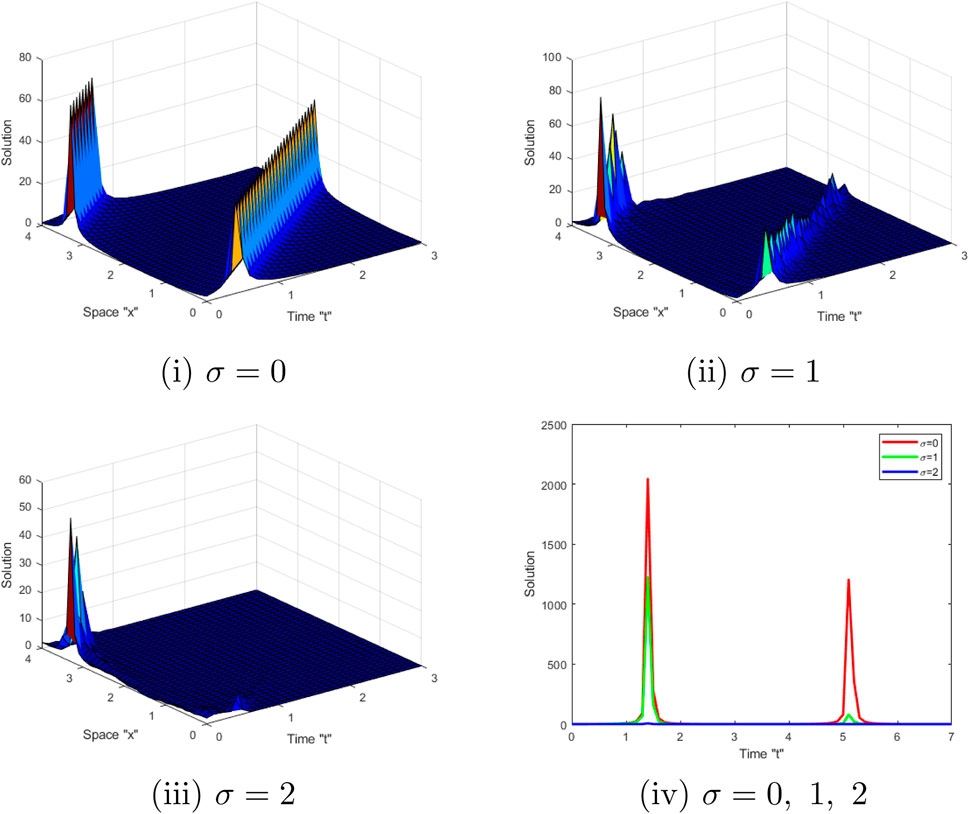- Department of Mathematical Science, College of Science, Princess Nourah Bint Abdulrahman University, Riyadh, Saudi Arabia
Here, we consider the stochastic (2 + 1)-dimensional Heisenberg ferromagnetic spin chain equation which is forced by the multiplicative Brownian motion in the Stratonovich sense. We utilize the (G′/G)-expansion method and the mapping method to attain the analytical solutions of the stochastic (2 + 1)-dimensional Heisenberg ferromagnetic chain equation. Various types of analytical stochastic solutions, such as the hyperbolic, elliptic, and trigonometric functions, have been obtained. Physicists can utilize these solutions to understand a variety of important physical phenomena because the magnetic soliton has been categorized as one of the interesting groups of nonlinear excitations representing spin dynamics in the semiclassical continuum Heisenberg systems. Moreover, we employ MATLAB tools to plot 3D and 2D graphs for some obtained solutions to address the influence of Brownian motion on these solutions.
1 Introduction
In many branches of science and mathematics, nonlinear evolution equations (NLEEs) play a crucial role in describing a wide range of phenomena that linear equations are unable to adequately explain. These equations involve nonlinear terms that can lead to diverse and often intricate behaviors, making their study both fascinating and challenging. NLEEs have also found significant applications in various branches of physics and engineering. In fluid dynamics, the famous Navier–Stokes equations describe the behavior of fluids which are inherently nonlinear due to their viscosity and turbulent effects. Understanding and solving these equations is essential for predicting weather patterns, optimizing industrial processes, and designing efficient aerodynamics. Additionally, NLEEs have been instrumental in quantum field theory, providing insights into particle physics and the dynamics of elementary particles.
In mathematics, the study of NLEEs has led to the development of several powerful analytical and numerical techniques. Some of these methods include Jacobi elliptic function [1],
On the other hand, stochastic NLEEs (SNLEEs) play a crucial role in various scientific fields, including physics, finance, and probability theory. These equations incorporate random variations into deterministic equations, adding a stochastic term that captures the inherent uncertainty in the system. The addition of the stochastic term is of paramount importance as it allows us to better model and understand real-world phenomena by accounting for unpredictable factors and fluctuations. Furthermore, the addition of stochastic terms helps capture the complexity and nonlinearity of real-world systems. Many physical and financial systems exhibit a nonlinear behavior, where small changes in the initial conditions or parameters can lead to drastic and unpredictable outcomes. Traditional deterministic NLEEs often fail to accurately capture this nonlinear behavior. By introducing stochastic terms, we can better model the inherent randomness and nonlinearity of these systems, leading to more realistic and insightful solutions.
It looks more significant when considering models of NLEEs with random forces. Therefore, here, we consider one of the most important models in the modern magnetic theory, the stochastic Heisenberg ferromagnetic spin chain equation (SHFSCE), derived using multiplicative Brownian motion in the Stratonovich sense, which has the following form:
where ψ is a complex stochastic function of the variables x, y, and t and ki is the constant for i = 1, 2, 3, and 4. σ is the noise intensity, and
A deterministic Heisenberg ferromagnetic equation (DHFE) has been created to interpret magnetic ordering in ferromagnetic materials. It plays an important role in the modern magnetic theory, which describes nonlinear magnet dynamics and is used in optical fibers. Due to the importance of DHFE, many authors have attained the exact solution for this equation by using various methods, such as Hirota’s bilinear method [13, 14], Darboux transformation [15–17], sub-ODE method [18], sine-Gordon and modified exp-function expansion methods [19], auxiliary ordinary differential equation [20], Jacobi elliptic functions [21], F-expansion method combined with Jacobi elliptic functions [22], and generalized Riccati mapping method and improved auxiliary equation [23], while many authors have investigated the analytical solutions of fractional DHFE by using various methods, including exp (−ϕ(ς))-expansion and extended tanh function [24], new extended generalized Kudryashov [25], and generalized Riccati equation mapping methods [26].
The main motivation of this work is to obtain the analytical stochastic solutions of Eq. 1 using the (G′/G)-expansion and mapping methods. Physicists could utilize the acquired solution to interpret a variety of fascinating physical phenomena because the magnetic soliton has been categorized as one of the interesting groups of nonlinear excitations representing spin dynamics in the semiclassical continuum Heisenberg systems. Moreover, we show the influence of Brownian motion on the behavior of these solutions using MATLAB tools to exhibit some graphical representations.
The remainder of this article is organized as follows: in Section 2, we define the Brownian motion and state the relationship between the Stratonovich and Itô integrals. In Section 3, we derive the wave equation of SHFSCE (1). In Section 4, we apply the
2 Brownian motion
Brownian motion refers to the random movement of microscopic particles suspended in a fluid. It was first observed by the Scottish botanist Robert Brown in 1827 when he noticed pollen grains jiggling randomly in water under a microscope. This discovery paved the way for the development of the kinetic theory of gases and had a profound impact on our understanding of the physical world. Brownian motion has applications in a wide range of scientific disciplines. In physics, it has been used to determine fundamental constants, such as Avogadro’s number, by measuring the displacement of particles in a known volume under known conditions. In chemistry, it has been utilized to study the diffusion of molecules, enabling the determination of molecular sizes and diffusion coefficients. In biology, it has been employed to study the movement of microscopic organisms and the dynamics of biological macromolecules.
Now, let us define the Brownian motion
Definition 1. The stochastic process
1.
2.
3.
4. The increments
We need the following lemma:
Lemma 1.
We note that there are two widely used versions of stochastic integrals, Stratonovich and Itô [27, 28]. Modeling issues usually dictate determination of the acceptable version; however, once the version is selected, a comparable equation of the other version can be established with the same solutions. Thus, it is possible to switch between Itô (denoted by
where f is assumed to be sufficiently regular and {Xt, t ≥0} is a stochastic process.
3 The wave equation of SHFSCE
To derive the wave equation of SHFSCE, we employ the next wave transformation:
where u is a real deterministic function and ηi and θi for all i = 1, 2, and 3 are constants. We note that
and
where the term
Substituting Eq. 3 into (1) and utilizing Eqs 4, 5, we obtain the following equation for the imaginary part:
where we assume that
Furthermore, we derive the following equation for the real part:
where
Taking expectation on both sides of Eq. 8, we attain
where u represents the deterministic function. Using Lemma 1, Eq. 9 attains the following form:
4 Exact solutions of SHFSCE
To find the solutions of Eq. 10, we apply the (G′/G)-expansion [2] and mapping methods. Subsequently, we attain the solutions of SHFSCE (1).
4.1 (G′/G)-expansion method
To begin, let us assume that the solution of Eq. 10 has the following form:
where b0, b1, ..., bN denote unknown constants, such that bN ≠ 0, and G solves
where λ and ν are undefined constants. By balancing u3 with u′′ in Eq. 10, we obtain
From Eq. 13, we can rewrite Eq. 11 as
Substituting Eq. 14 into Eq. 10 and utilizing Eq. 12, we obtain
Equating each coefficient of
and
We obtain the following equation by solving these equations:
The roots of auxiliary Eq. 12 are
Depending on ℏ2, a variety of situations might arise, which are as follows:
Case 1: If ℏ2 = 0, then
where c1 and c2 are constants. Hence, by using Eq. 14, the solution of Eq. 10 is
As a result, SHFSCE (1) derives the solution
where η = η1x + η2y − (2k1η1θ1 + 2k2η2θ2 + k3η1θ2 + k3η2θ1)t and θ = θ1x + θ2y + θ3t.
Case 2: If ℏ2 <0, then
Therefore, the solution of Eq. 10 is
Consequently, the solution of SHFSCE (1) is
Case 3: If ℏ2 >0, then
Hence, the solution of Eq. 10 is
Thus, the solution of SHFSCE (1) is
where η = η1x + η2y − (2k1η1θ1 + 2k2η2θ2 + k3η1θ2 + k3η2θ1)t and θ = θ1x + θ2y + θ3t.
Special cases
Case 1: Substituting c2 = 0 and λ = 0 into Eq. 21, we obtain
Case 2: Substituting c1 = 0 and λ = 0 into Eq. 21, we obtain
Case 3: If we substitute c1 = c2 = 1 and λ = 0 into Eq. 21, then
Case 4: Substituting c1 = c2 = 1 and
Case 5: Substituting c1 = c2 = 1 and
Case 6: Substituting c1 = c2 = 1 and λ = 0 into Eq. 19, we derive
Case 7: Substituting c1 = 1, c2 = −1, and λ = 0 into Eq. 19, we derive
where η = η1x + η2y − (2k1η1θ1 + 2k2η2θ2 + k3η1θ2 + k3η2θ1)t and θ = θ1x + θ2y + θ3t.
Remark 3. Eqs 22–27 with σ = 0 coincide with the results reported in [24].
4.2 Mapping method
Let the solutions of Eq. 10 take the following form:
where ℓ0 and ℓ1 denote the undetermined constants and φ solves the first elliptic equation:
where the parameters r, q, and p all denote real numbers. Substituting Eq. 28 into Eq. 10, we obtain
Equating each coefficient of φk to zero, we derive
and
Solving these equations, we obtain
Substituting into Eq. 28, we derive the solutions of Eq. 10 in the following form:
Consequently, the solutions of SHFSCE (1), utilizing Eq. 3, are
Depending on p and ℏ1, a variety of cases might arise, which are as follows:
Case 1: If p =,
When
Case 2: If p =
When
If
Case 3: If p =
When
Case 4: If p =
When
Case 5: If p =
If
Case 6: If p =
If
Case 7: If p = 1, q = 0, and r = 0, then the solution of Eq. 29 is
Case 8: If
When
If
Case 9: If
When
Case 10: If
Case 11: If
When
5 Brownian motion’s influence
In this section, we address the influence of Brownian motion on solutions of SHFSCE (1). We provide numerous graphical representations to demonstrate the influence of Brownian motion on the behavior of these solutions. First, let us fix the parameters k1 = 2.5, k2 = k3 = 1.5, k4 = 0.5, and η1 = η2 = θ1 = θ2 = 1. MATLAB is used to plot some solutions, such as [22], for x ∈ [0, 4], y = 1, and t ∈ [0, 4] and for various σ values (noise intensity) as follows:
When examining the surface at σ = 0, it is apparent from Figure 1, Figure 2, and Figure 3 that there is a fluctuation and that the surface is not smooth. When noise is added and its intensity is increased by a factor of σ = 1 and 2, the surface becomes substantially flatter after minor transit patterns. This demonstrates that the Brownian motion influences the solutions of SHFSCE and stabilizes them at zero.

FIGURE 1. (i–iii) 3D profile of the solution

FIGURE 2. (i–iii) 3D profile of the solution

FIGURE 3. (i–iii) 3D profile of the solution
6 Conclusion
In this article, we considered SHFSCE (1) forced by multiplicative Brownian motion. The stochastic solutions to this problem were obtained using two separate methods: the (G′/G)-expansion approach and the mapping method. These solutions are much more accurate and helpful in comprehending several critical complicated physical processes. Some previously obtained solutions, such as those described in [24], were extended. Finally, we used MATLAB tools to show the influence of multiplicative Brownian motion on the solutions of SHFSCE using graphical representations.
Data availability statement
The original contributions presented in the study are included in the article/Supplementary Material; further inquiries can be directed to the corresponding author.
Author contributions
FA-A: conceptualization, data curation, formal analysis, funding acquisition, investigation, methodology, software, writing–original draft, and writing–review and editing.
Funding
The author(s) declare that no financial support was received for the research, authorship, and/or publication of this article.
Acknowledgments
Princess Nourah bint Abdulrahman University Researcher Supporting Project number (PNURSP2023R 273), Princess Nourah bint Abdulrahman University, Riyadh, Saudi Arabia.
Conflict of interest
The author declares that the research was conducted in the absence of any commercial or financial relationships that could be construed as a potential conflict of interest.
Publisher’s note
All claims expressed in this article are solely those of the authors and do not necessarily represent those of their affiliated organizations, or those of the publisher, the editors, and the reviewers. Any product that may be evaluated in this article, or claim that may be made by its manufacturer, is not guaranteed or endorsed by the publisher.
References
1. Yan ZL. Abundant families of Jacobi elliptic function solutions of the (2+1)-dimensional integrable Davey–Stewartson-type equation via a new method. Chaos Solitons Fractals (2003) 18:299–309. doi:10.1016/s0960-0779(02)00653-7
2. Wang ML, Li XZ, Zhang JL. The (G′/G) -expansion method and travelling wave solutions of nonlinear evolution equations in mathematical physics. Phys Lett A (2008) 372:417–23. doi:10.1016/j.physleta.2007.07.051
3. Zhang H. New application of the (G′/G) -expansion method. Commun Nonlinear Sci Numer Simul (2009) 14:3220–5. doi:10.1016/j.cnsns.2009.01.006
4. Wazwaz AM. A sine-cosine method for handling nonlinear wave equations. Math Comput Model (2004) 40:499–508. doi:10.1016/j.mcm.2003.12.010
5. Yan C. A simple transformation for nonlinear waves. Phys Lett A (1996) 224:77–84. doi:10.1016/s0375-9601(96)00770-0
6. Mohammed WW. Approximate solution of the Kuramoto-Shivashinsky equation on an unbounded domain. Chin Ann Math Ser B (2018) 39:145–62. doi:10.1007/s11401-018-1057-5
7. Mohammed WW. Modulation equation for the stochastic swift–hohenberg equation with cubic and quintic nonlinearities on the real line. mathematics (2020) 6:1–12. doi:10.3390/math7121217
8. Khan K, Akbar MA. The exp(−φ(ς)) -expansion method for finding travelling wave solutions of Vakhnenko-Parkes equation. Int J Dyn Syst Differ Equ (2014) 5:72–83. doi:10.1504/ijdsde.2014.067119
9. Hirota R. Exact solution of the Korteweg-de Vries equation for multiple collisions of solitons. Phys Rev Lett (1971) 27:1192–4. doi:10.1103/physrevlett.27.1192
10. Wazwaz AM. The tanh method: exact solutions of the sine-Gordon and the sinh-Gordon equations. Appl Math Comput (2005) 167:1196–210. doi:10.1016/j.amc.2004.08.005
11. Malfliet W, Hereman W. The tanh method. I. Exact solutions of nonlinear evolution and wave equations. Phys Scr (1996) 54:563–8. doi:10.1088/0031-8949/54/6/003
12. Yang XF, Deng ZC, Wei Y. A Riccati-Bernoulli sub-ODE method for nonlinear partial differential equations and its application. Adv Diff Equa (2015) 1:117–33. doi:10.1186/s13662-015-0452-4
13. Liu DY, Tian B, Jiang Y, Xie XY, Wu XY. Analytic study on a (2+1)-dimensional nonlinear Schrödinger equation in the Heisenberg ferromagnetism. Comput Math Appl (2016) 71:2001–7. doi:10.1016/j.camwa.2016.03.020
14. Zhao XH, Tian B, Liu DY, Wu XY, Chai J, Guo YJ. Dark solitons interaction for a (2 +1)-dimensional nonlinear Schrödinger equation in the Heisenberg ferromagnetic spin chain. Supperlatt Microstruct (2016) 100:587–95. doi:10.1016/j.spmi.2016.10.014
15. Ling LM, Liu QP. Darboux transformation for a two-component derivative nonlinear Schrödinger equation. J Phys A (2010) 43:434023. doi:10.1088/1751-8113/43/43/434023
16. Li CZ, He JS. Darboux transformation and positons of the inhomogeneous Hirota and the Maxwell-Bloch equation. Sci China-phys Mech Astr (2014) 57:898–907. doi:10.1007/s11433-013-5296-x
17. Ma WX, Zhang YJ. Darboux transformations of integrable couplings and applications. Rev Math Phys (2018) 30:1850003. doi:10.1142/s0129055x18500034
18. Tang GS, Wang SH, Wang GW. Solitons and complexitons solutions of an integrable model of (2+1)-dimensional Heisenberg ferromagnetic spin chain. Nonlinear Dynam (2017) 88:2319–27. doi:10.1007/s11071-017-3379-3
19. Sulaiman TA, Akturk T, Bulut H, Baskonus HM. Investigation of various soliton solutions to the Heisenberg ferromagnetic spin chain equation. J Electromagnet Wave (2018) 32:1093–105. doi:10.1080/09205071.2017.1417919
20. Wang QM, Gao YT, Su CQ, Mao BQ, Gao Z, Yang JW. Dark solitonic interaction and conservation laws for a higher-order (2 +1)-dimensional nonlinear Schrödinger-type equation in a Heisenberg ferromagnetic spin chain with bilinear and biquadratic interaction. Ann Phys (2015) 363:440–56. doi:10.1016/j.aop.2015.10.001
21. Triki H, Wazwaz AM. New solitons and periodic wave solutions for the (2 +1)-dimensional Heisenberg ferromagnetic spin chain equation. J Electromagn Waves Appl (2016) 30:788–94. doi:10.1080/09205071.2016.1153986
22. Ma YL, Li BQ, Fu YY. A series of the solutions for the heisenberg ferromagnetic spin chain equation. Math Methods Appl Sci (2018) 41:3316–22. doi:10.1002/mma.4818
23. Seadawy AR, Nasreen N, Lu D, Arshad M. Arising wave propagation in nonlinear media for the (2+1)-dimensional Heisenberg ferromagnetic spin chain dynamical model. Physica A (2020) 538:122846. doi:10.1016/j.physa.2019.122846
24. Bashar H, Islam SMR, Kumard D. Construction of traveling wave solutions of the (2+1)-dimensional Heisenberg ferromagnetic spin chain equation. Partial Differential Equations Appl Maths (2021) 4:100040. doi:10.1016/j.padiff.2021.100040
25. Seadawy AR, Yasmeen A, Raza N, Althobaiti S. Novel solitary waves for fractional (2+1)-dimensional Heisenberg ferromagnetic model via new extendedgeneralized Kudryashov method. Phys Scr (2021) 96:125240. doi:10.1088/1402-4896/ac30a4
26. Rani M, Ahmed N, Dragomir SS, Mohyud-Din ST. New travelling wave solutions to (2+1)-Heisenberg ferromagnetic spin chain equation using Atangana’s conformable derivative. Phys Scr (2021) 96:094007. doi:10.1088/1402-4896/ac07b9
27. Kloeden PE, Platen E. Numerical solution of stochastic differential equations. New York: Springer-Verlag (1995).
Keywords: stochastic Heisenberg ferromagnetic equation, Brownian motion, mapping method, (G′/G)-expansion method, noise
Citation: Al-Askar FM (2023) The solitary wave solutions of the stochastic Heisenberg ferromagnetic spin chain equation using two different analytical methods. Front. Phys. 11:1267673. doi: 10.3389/fphy.2023.1267673
Received: 26 July 2023; Accepted: 03 October 2023;
Published: 20 October 2023.
Edited by:
Chun-Hui He, Xi’an University of Architecture and Technology, ChinaReviewed by:
Marwan Alquran, Jordan University of Science and Technology, JordanMuhammad Nadeem, Qujing Normal University, China
Copyright © 2023 Al-Askar. This is an open-access article distributed under the terms of the Creative Commons Attribution License (CC BY). The use, distribution or reproduction in other forums is permitted, provided the original author(s) and the copyright owner(s) are credited and that the original publication in this journal is cited, in accordance with accepted academic practice. No use, distribution or reproduction is permitted which does not comply with these terms.
*Correspondence: Farah M. Al-Askar, ZmFtYWxhc2thckBwbnUuZWR1LnNh
 Farah M. Al-Askar
Farah M. Al-Askar